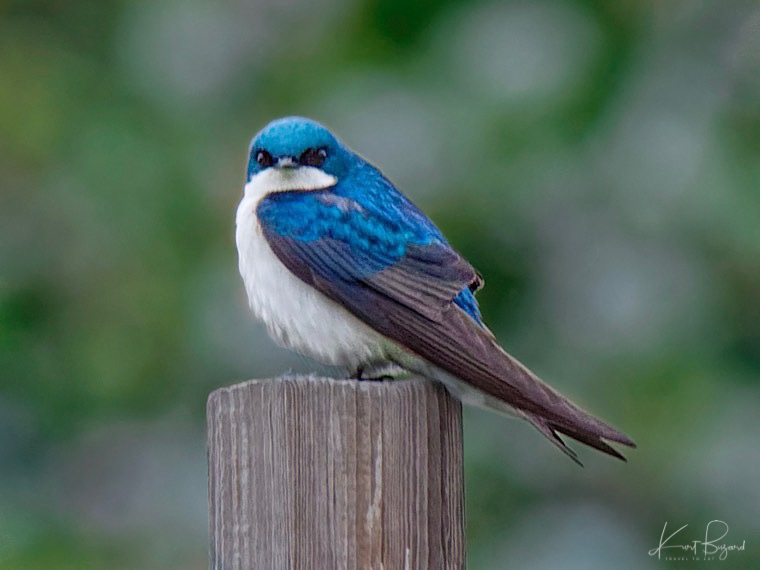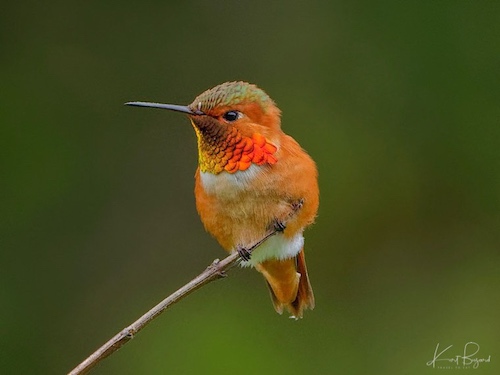
This past spring I traveled to Arcata California for some birdwatching in the Pacific Northwest. In Arcata, they have a bird festival in April called Godwit Days that I could not attend. Nonetheless, I thought it might be an interesting time and place for birding. The local Audubon Society says birding is at its best from winter through early May. You’ll find songbirds in spring through fall, shorebirds, wading birds and waterfowl in the cooler months of October through April, and raptors year round. As predicted, April was not a particularly good time for water birds, although there were songbirds and plenty of spring flowers. Nearly 500 species of birds have been found in Humboldt County; many of these species are unique to Humboldt County. Fortunately I was able to secure Rob Fowler as a guide to the birding areas around Arcata. He knew when and where to look and made most of the following pictures possible. I suspect I will return in a different season to see a different set of birds and of course to see the beautiful scenery in a different light.
Allen’s Hummingbird
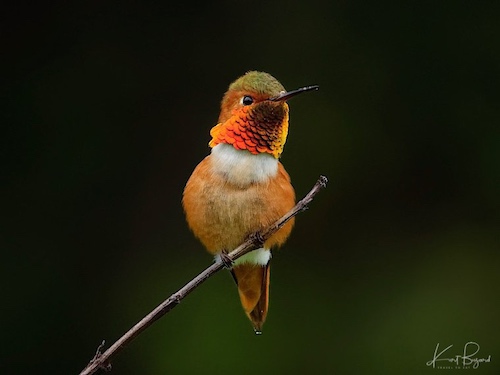
Allen’s Hummingbird (Selasphorus sasin) is a small bird, with mature adults reaching only 3 to 3.5 in (76 to 89 mm) in length. Females are mostly green, featuring rufous color only on the tail, which also has white tips. Allen’s hummingbird is common only in the brushy woods, gardens, and meadows of coastal California from Santa Barbara north, and southern coastal Oregon. The northern population is migratory, and winters along the Pacific coast of central Mexico. Allen’s Hummingbird and Rufous Hummingbird males both sport an orange gorget and are nearly identical, but their ranges differ considerably. While Allen’s breeds along the California coast and just into Oregon, Rufous’s range begins in Oregon and extends all the way into Alaska.
Anna’s Hummingbird
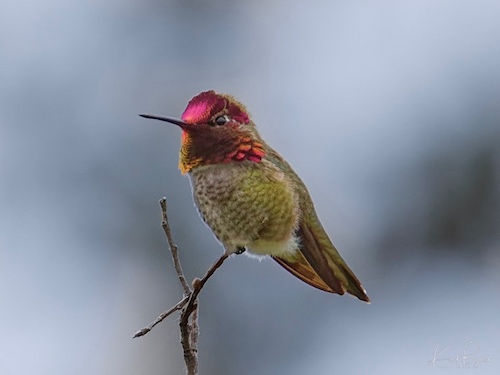
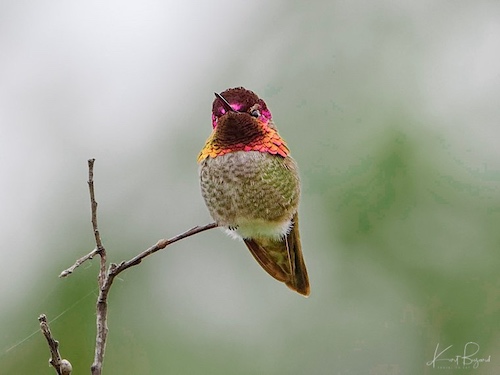
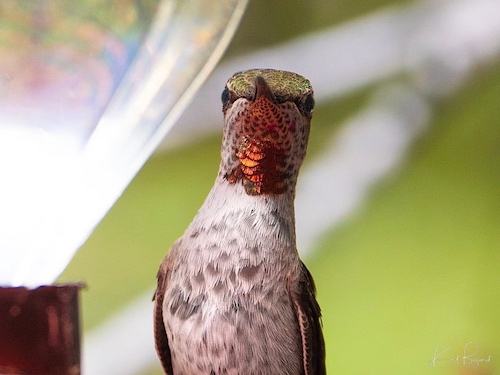
Anna’s Hummingbird is a medium-sized hummingbird, 3.9–4.3 in (9.9–10.9 cm) long, native to the west coast of North America. It was named after Anna Masséna, Duchess of Rivoli. In the early 20th century, Anna’s Hummingbirds bred only in northern Baja California and southern California. The transplanting of exotic ornamental plants in residential areas throughout the Pacific coast and inland deserts provided expanded nectar and nesting sites, allowing the species to expand its breeding range. They tend to be permanent residents within their range, and are very territorial. However, birds have been spotted far outside their range in such places as southern Alaska, Saskatchewan, New York, Florida, Louisiana, and Newfoundland.
Broad-Billed Hummingbird
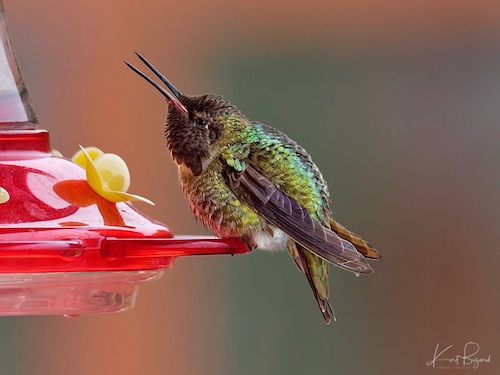
The broad-billed hummingbird is a medium-sized hummingbird, 3.5–3.9 in /(9–10 cm) long, and weighs approximately 0.1–0.4 oz (3–4 gm). The breeding habitat is in arid scrub of the Sonoran and Chihuahuan Desert ecotone and the Madrean Sky Islands in southeastern Arizona, extreme southwestern New Mexico and northern Sonora of Northwestern Mexico. It was sighted in California for the first time in 1961 in San Diego County. The overall pattern of northward dispersal in fall and winter of subtropical hummingbirds, including both first-year birds and adults, is nothing short of remarkable. The Broad-Billed is perhaps the quintessential species exhibiting this tendency, although the Green Violet-Ear (Colibri thalassinus) could also legitimately make this claim. I saw this fat specimen on a feeder at a friend of Rob Fowler in Arcata.
Song Sparrow
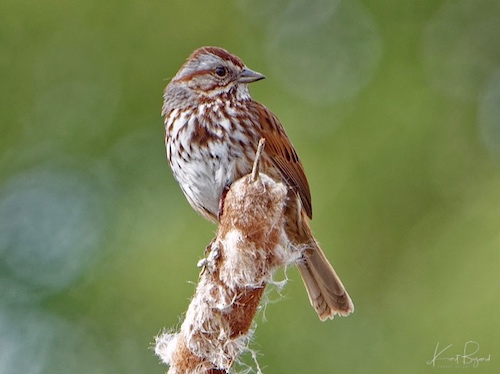
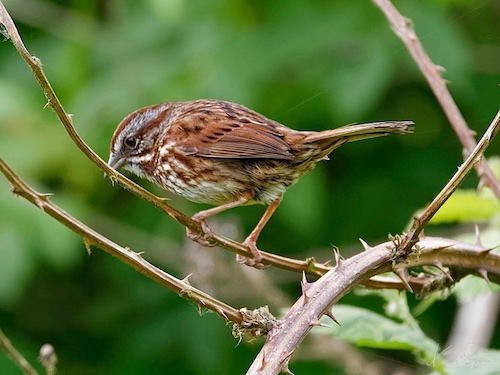
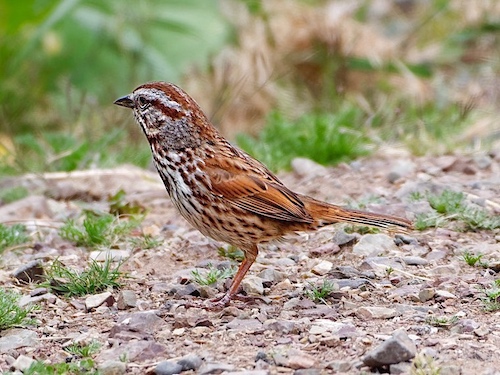
Song Sparrows have the greatest number of genetically distinct populations of any bird in North America. The total number of subspecies is much debated, but the most recent study suggests there are perhaps as few as 24 in total, 11 that breed in California, and 8 that are endemic to the state. Four additional subspecies winter in California. Along the coast from northern Mendocino, through Humboldt and Del Norte Counties the subspecies of the Song Sparrow (Melospiza melodia cleonensis) is present. As you can see in the above photos, this subspecies is very rufous and actually quite beautiful for a Song Sparrow.
Purple Finch
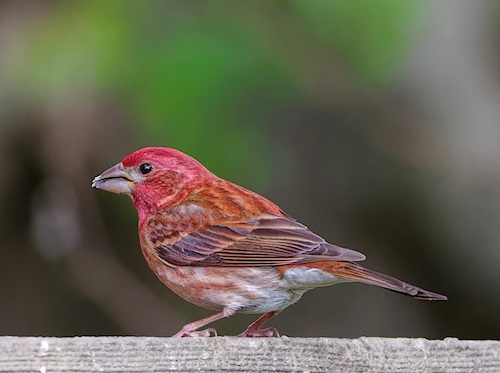
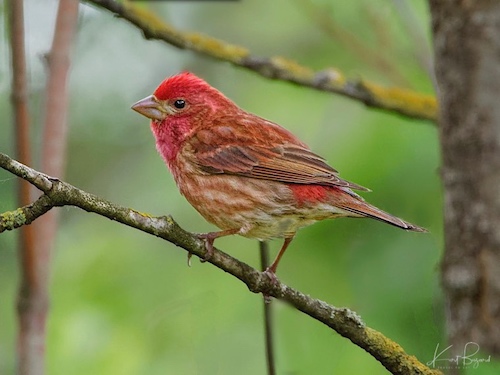
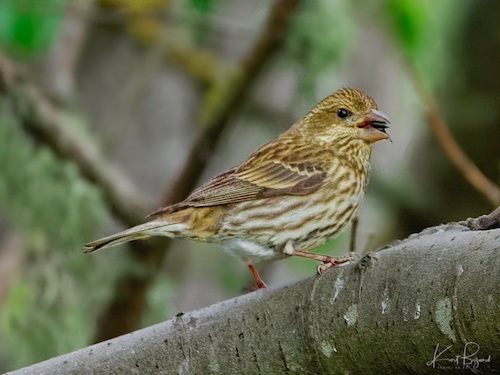
The Purple Finch is rare in the Southwest and Rocky Mountains but very common in Humboldt County. Their breeding habitat is coniferous and mixed forest in Canada and the northeastern United States, as well as various wooded areas along the U.S. Pacific coast. The California subspecies Haemorhous purpureus californicus was identified by Spencer F. Baird in 1858. It differs from the nominate subspecies in that it has a longer tail and shorter wings. The plumage of both males and females is darker, and the coloration of the females is more greenish.
House Finch
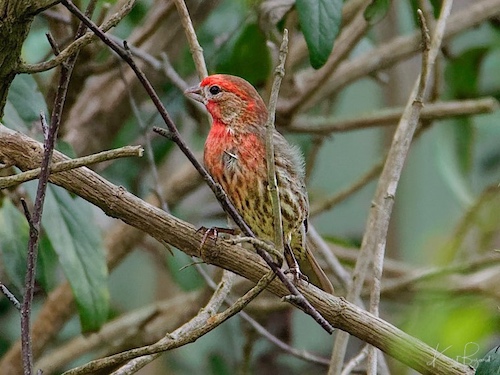
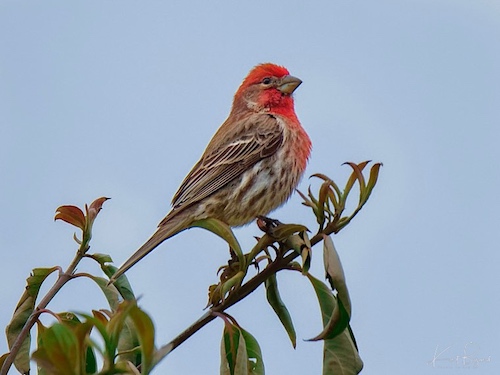
The main difference between a House Finch and a Purple Finch is the shade of red and location of of the color. The Purple Finch is a raspberry red, sometimes described as old-rose red while the House Finch is more of an orange red. Color is helpful, but it varies among individuals. The Purple Finch is a bulkier bird with a larger straight beak and the color goes over the back and wings. The House Finch usually has red on the forehead and breast with brown cheeks and brown on top of the head. Females and young males of both species are simply brown and white, and can be especially tricky.
Chestnut-Backed Chickadee
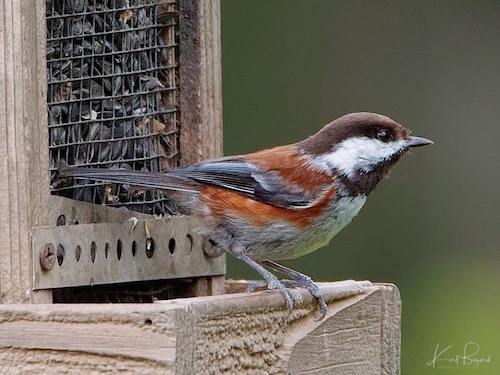
The Chestnut-Backed Chickadee is found in the Pacific Northwest of the United States and western Canada, from southern Alaska to southwestern California. It is a permanent resident within its range, with some seasonal movements as feeding flocks move short distances in search of food. It is a small chickadee, 4.5–4.9 in (11.5–12.5 cm) long with a weight of 0.30–0.44 oz (8.5–12.6 gm). Male, female and juvenile Chestnut-Backed Chickadees all share the same plumage.
American Goldfinch
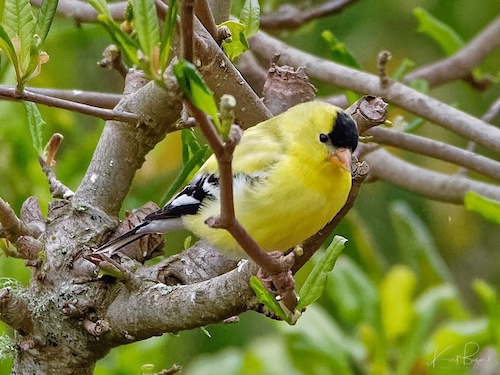
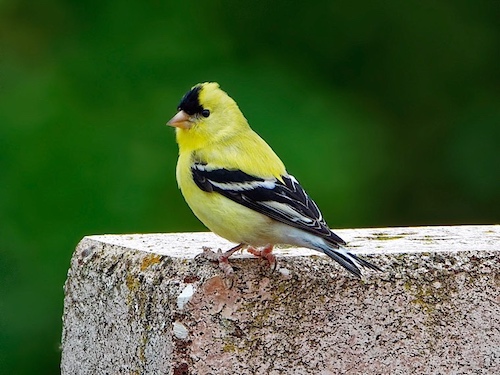

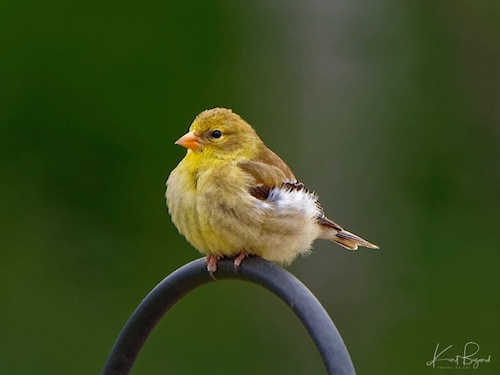
The American goldfinch is a small finch, 4.3–5.5 in (11–14 cm) long and weighs between 0.39–0.71 oz (11–20 gm). The American Goldfinch prefers open country where weeds thrive, such as fields, meadows, flood plains, as well as roadsides, orchards, and gardens. The summer breeding range stretches across North America from coast to coast. It is bounded on the north by Saskatchewan and stretches south across North America to North Carolina on the east coast, and northern California on the west coast. Its winter range includes southern Canada and stretches south through the United States to parts of Mexico. The female is mostly brown, lighter on the underside with a yellow bib.
Black-Headed Grosbeak
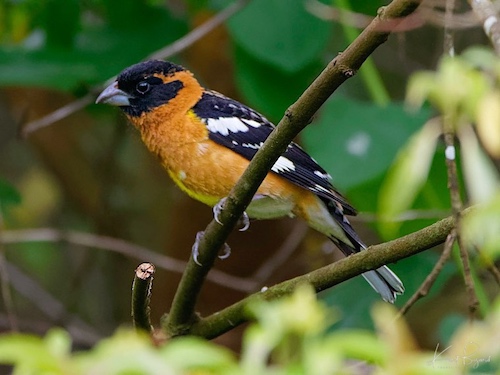
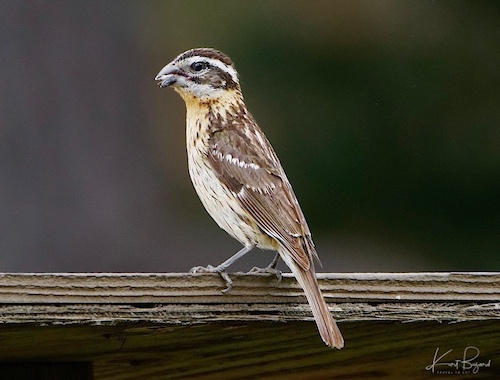
The Black-Headed Grosbeak is a medium-sized, seed-eating bird in the same family as the northern cardinal. The 7.5 in (19 cm) long, 1.7 oz (47 gm) black-headed grosbeak is a migratory bird, with nesting grounds from southwestern British Columbia, through the western half of the United States, into central Mexico. It occurs as a vagrant further south in Central America. I have personally seen it in Costa Rica.
Brown Headed Cowbird
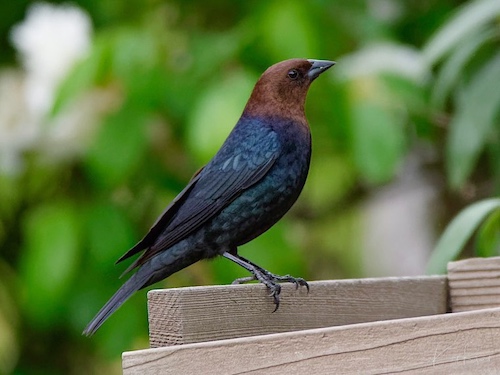
The brown-headed cowbird (Molothrus ater) is native to subtropical North America. They are permanent residents in the southern parts of their range; northern birds migrate to the southern United States and Mexico in winter, returning to their summer habitat around March or April. They lay their eggs in other birds nests.
Tree Swallow
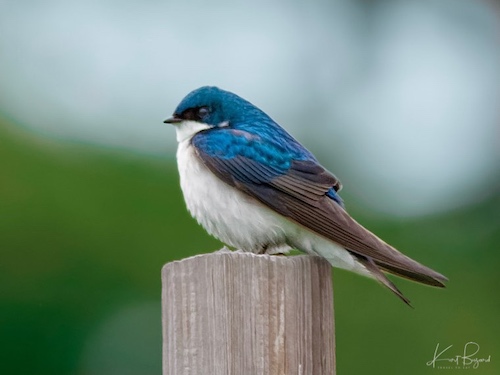
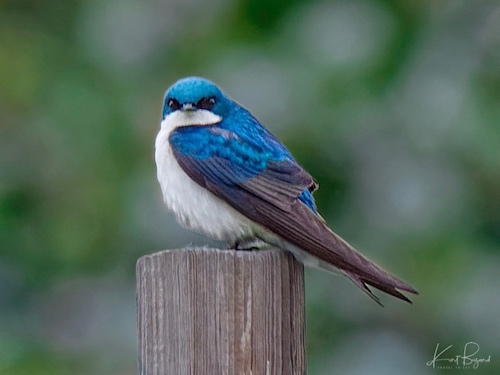
The Tree Swallow breeds in the US and Canada. It winters along southern US coasts south, along the Gulf Coast, to Panama and the northwestern coast of South America, and in the West Indies. The tree swallow has a length between about 4.7–5.5 in (12–14 cm) and a weight of approximately 0.6–0.9 oz (17–25.5 gm). An aerial insectivore, the tree swallow forages both alone and in groups, eating mostly insects, in addition to molluscs, spiders, and fruit. The female is generally duller than the male, and the first-year female has mostly brown upperparts, with some blue feathers.
Black Phoebe
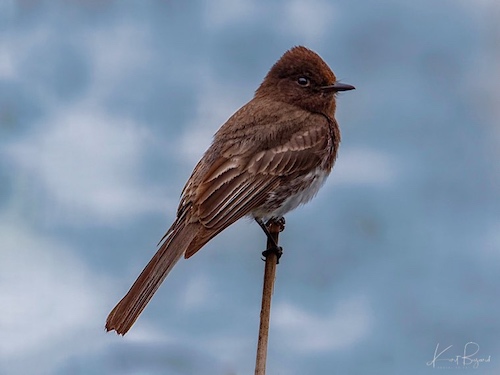
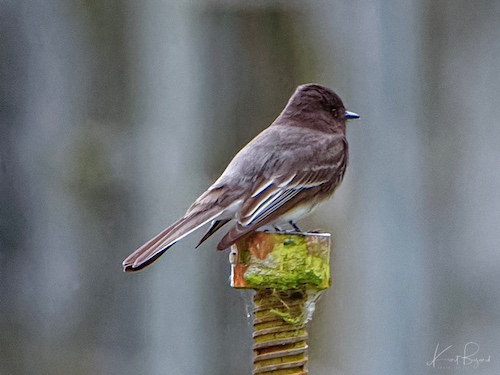
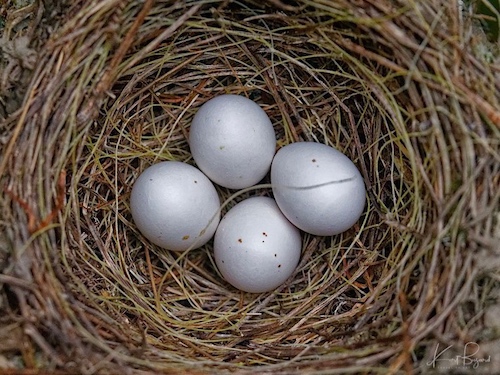
The Black Phoebe breeds from southwest Oregon and California south through Central and South America. It occurs year-round throughout most of its range and migrates less than the other birds in its genus, though its northern populations are partially migratory. The black phoebe is a medium-sized flycatcher, being 6.3 in (16 cm) in length and weighing 0.5–0.8 oz (15 to 22 gm). The sexes are identical in color, and juveniles have brown feather tips and brown wing-bars. One of them had nested in an old well by the Mad River Fish Hatchery and I was able to get a photo of the nest.
Purple Martin
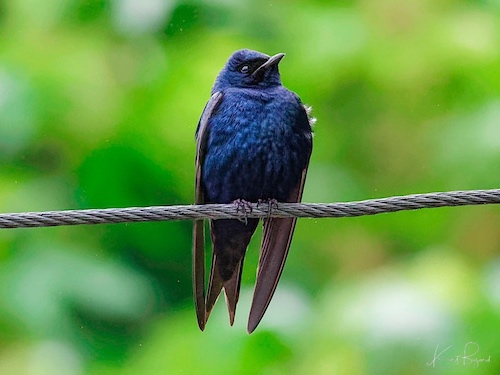
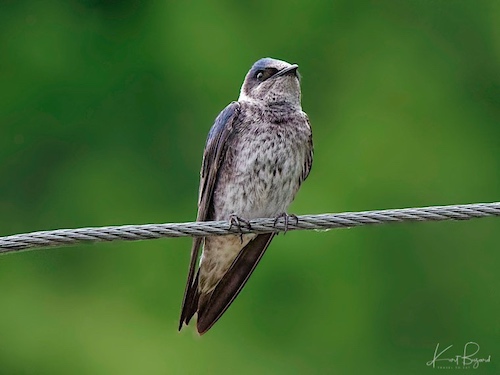
The Purple Martin is the largest North American swallow. The average length from bill to tail is 20 cm (7.9 in). Purple martins suffered a severe population crash in the 20th century widely linked to the release and spread of European starlings in North America. Starlings and House Sparrows compete with martins for nest cavities. Where Purple Martins once gathered by the thousands, by the 1980s they had all but disappeared. Wintering in South America, purple martins migrate to North America in spring to breed.
Steller’s Jay
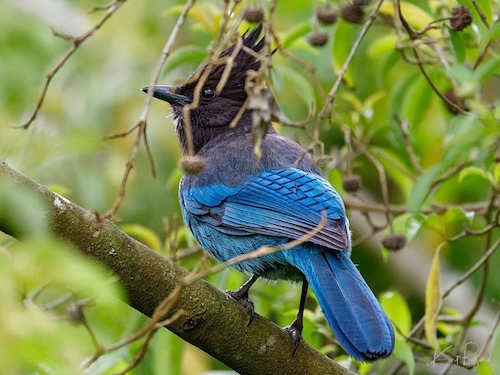
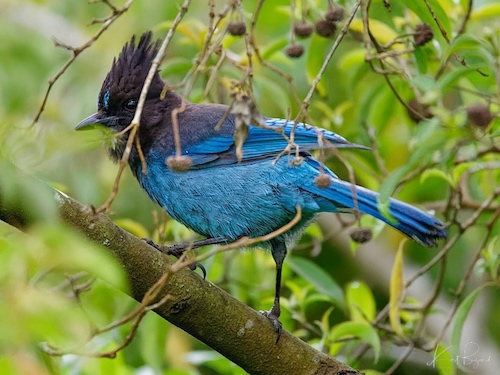
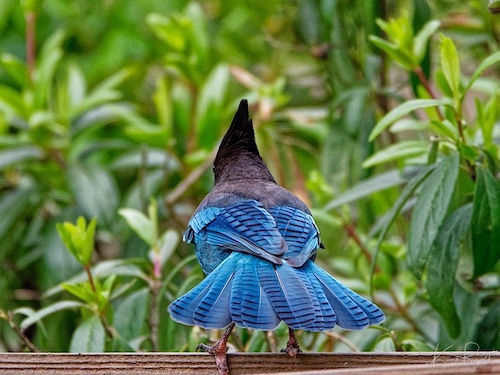
The Steller’s Jay occurs in most of the forested areas of western North America as far east as the eastern foothills of the Rocky Mountains from southern Alaska in the north to northern Nicaragua. Steller’s jay shows a great deal of regional variation throughout its range. Blackish-brown-headed birds from the north gradually become bluer-headed farther south. The Steller’s jay has a more slender bill and longer legs than the blue jay and has a much more pronounced crest. It is also somewhat larger. The Makahs (Northwest Coastal Native People) tell a story about how the bird we know as the Steller’s Jay, the bird the Makahs call Kwish-kwishee, got its crest. The mink, Kwahtie, tried to shoot his mother, the jay, with an arrow but missed. Her crest is ruffled to this day.
Cedar Waxwing
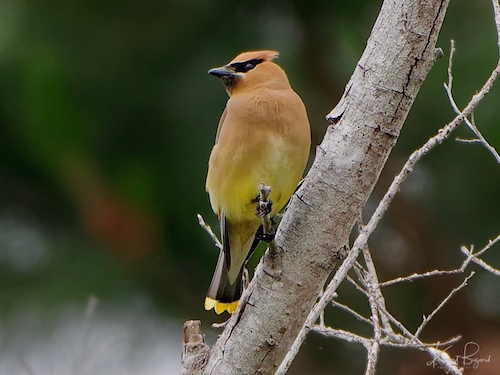
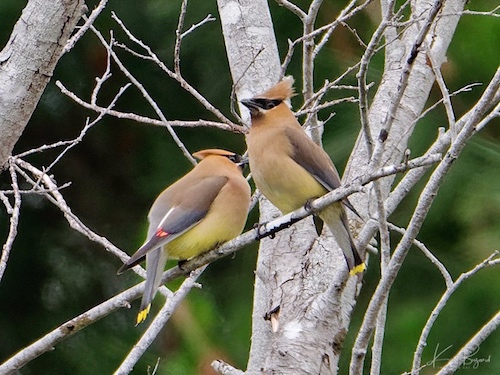
Cedar waxwings are medium-sized birds approximately 6–7 in (15–18 cm) long and weighing roughly 30 g (1.1 oz). It is a native of North and Central America, breeding in open wooded areas in southern Canada and wintering in the southern half of the United States, Central America, and the far northwest of South America. Its diet includes cedar cones, fruit, and insects.
Eurasian Collared Dove
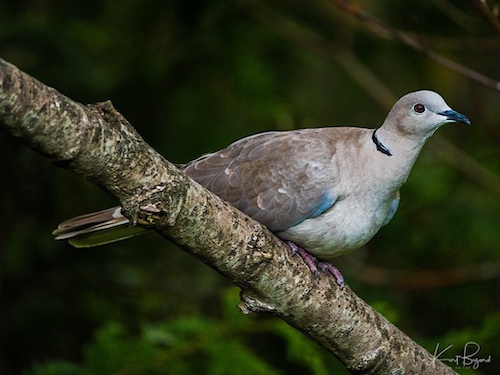
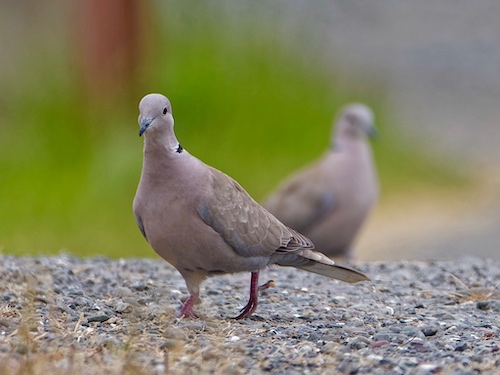
The Eurasian collared dove (Streptopelia decaocto) is a dove species native to Europe and Asia, which has been introduced to North America. The collared dove is not migratory, but is strongly dispersive. Over the last century, it has been one of the great colonisers of the bird world, travelling far beyond its native range to colonise colder countries, becoming a permanent resident in several. In 1974, fewer than 50 Eurasian Collared Doves escaped captivity in Nassau, New Providence, Bahamas. From the Bahamas, the species spread to Florida, and is now found in nearly every state in the US, as well as in Mexico.
European Starling (Sturnus vulgaris)
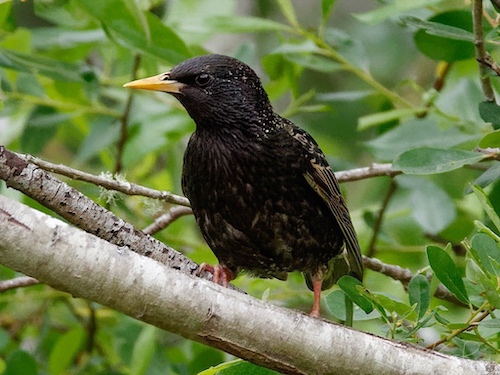
The European Starling was introduced in the United States in 1890 into New York’s Central Park. Large flocks typical of this species can be beneficial to agriculture by controlling invertebrate pests; however, starlings can also be pests themselves when they feed on fruit and sprouting crops. There were large numbers of blackbirds and European Starlings around Arcata, mainly in pastures.
California Towhee
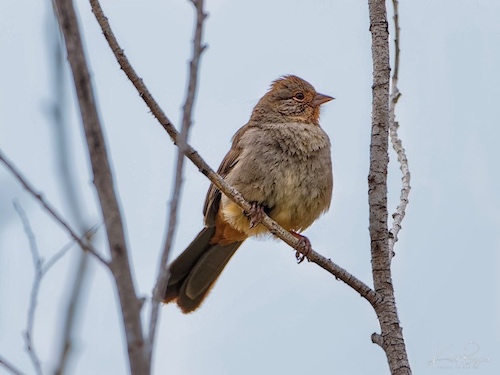
The California Towhee is native to the coastal regions of western Oregon and California in the United States and Baja California Sur in Mexico. The California Towhee’s coloring is dull brown overall with light rust undertail coverts and buff or rust colored streaks at the throat. Male and female look alike. It is around 7.9–9.8 in (20–25 cm) in length, and weigh an average of 1.83 oz (51.8 gm). The California towhee feeds on the ground or in low scrub where it prefers a variety of seeds and some insects. It is most often seen traveling or feeding singly or in pairs.
Brewer’s Blackbird
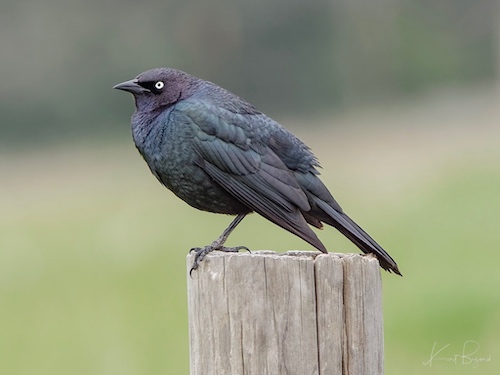
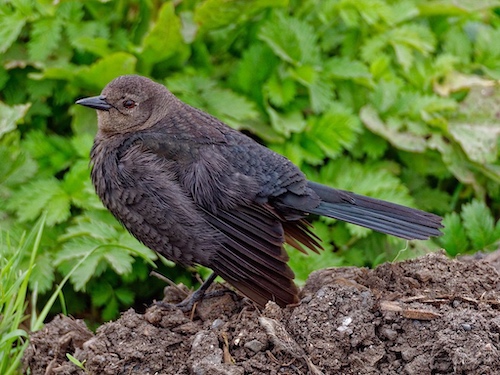
The Brewer’s Blackbird (Euphagus cyanocephalus) is a medium-sized New World blackbird. It is 8–10.3 in (20–26 cm) long and weighs 2.2 oz (63 g). These birds are often permanent residents in the west. Other birds migrate to the southeastern United States and Mexico. The range of this bird has been expanding east in the Great Lakes region.
Tricolored Blackbird
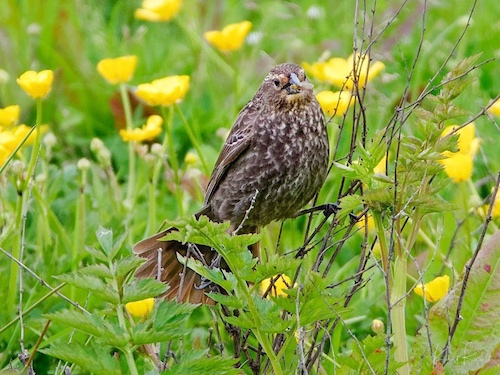
The Tricolored Blackbird is limited to the coastal areas of the Pacific coast of North America, from Northern California in the U.S. (with occasional strays into Oregon), to upper Baja California in Mexico. These were mixed in with European Starling and Brewer’s Blackbird in nearly all the cow pastures around Arcata. In 2006 the tricolored blackbird was classified as Endangered by BirdLife International. I took pictures of the male but none turned out.
California Quail
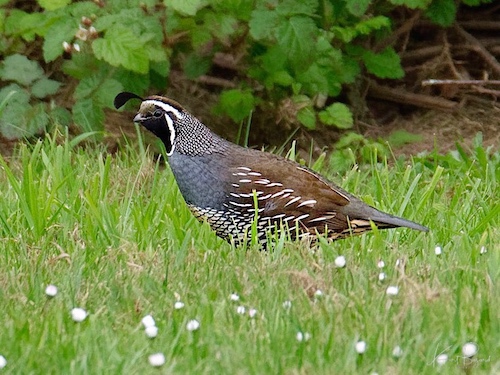
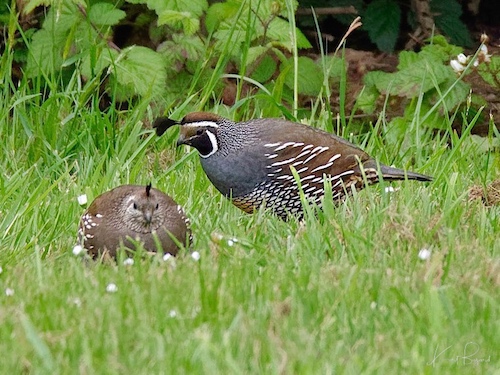
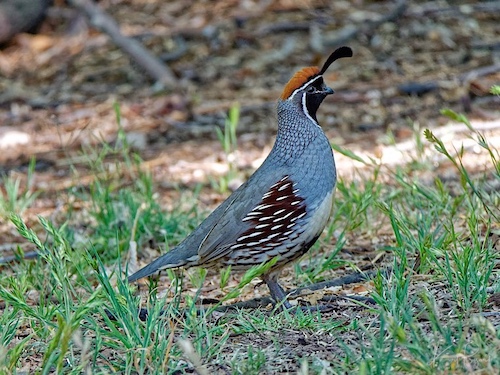
In the United States, California Quail are distributed along the coast and Gambel’s Quail generally in the interior. In Mexico California Quail are restricted to Baja California. As you can see above, California quail and Gambel’s quail can look very similar, though the Gambel’s quail has more reddish coloration on its cap and flanks, and a much larger, black patch on its lower abdomen. Overall, the Gambel’s Quail is more gray than the more brown California Quail. California Quail have scaly markings on the upper stomach whereas Gambel’s Quail are plainer. The pale forehead of the California quail is distinctive, as the Gambel’s quail has a dark forehead.
Other Critters
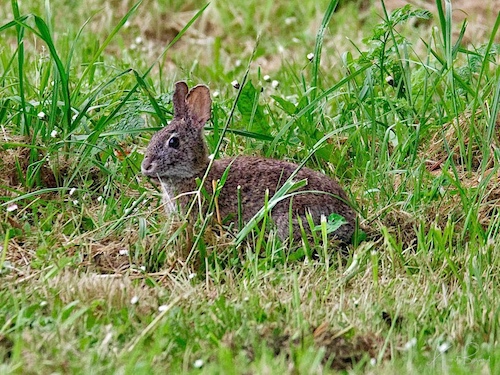
The Brush Rabbit is found in western coastal regions of North America, from the Columbia River in Oregon to the southern tip of the Baja California Peninsula. Its range extends as far east as the eastern sides of the Sierra Nevada and Cascade mountain ranges. The brush rabbit is smaller than many of the other cottontails, and unlike most of them, the underside of its tail is grey rather than white (which may be why its common name does not include the word “cottontail”). Adult rabbits measure anywhere from 10–14 inches long and rarely weigh over two pounds.
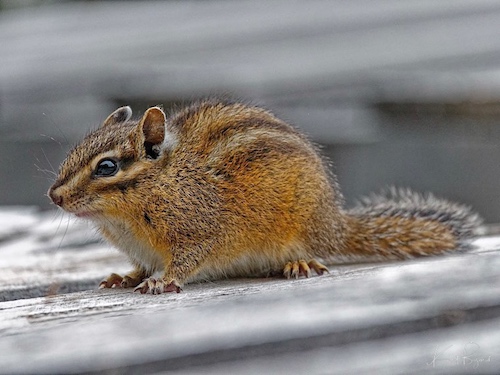
The Yellow-Cheeked Chipmunk is endemic to the coast region of northern California, where it is present in a strip of land nowhere wider than 40 km (25 mi). The southern end of its range is a few kilometers north of Bodego Bay and Freestone in Sonoma County and the northern end is the Eel River in Humboldt County. It is endemic to areas near the coast of northern California in the United States where it inhabits coastal coniferous forest. The yellow-cheeked chipmunk feeds on the seeds and fruits of a variety of plants and perhaps insects.
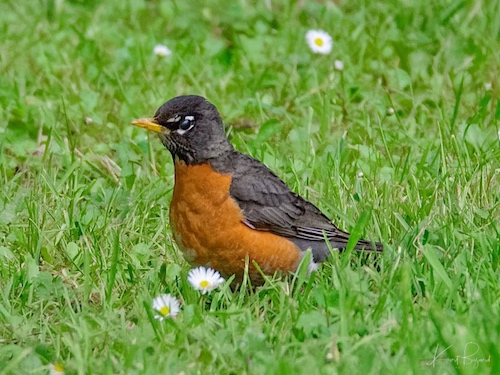
As always I hope you enjoyed the post, if you like, leave a comment or question.
References:
Rob Fowler’s Birds of Interest
Birding on California’s North Coast
Humboldt Bay Eagle Cam. Live Feed
Broad-Billed Hummingbirds in California
Broad-Billed Hummingbirds in Sonoma
Song Sparrows Subspecies in California
Song Sparrows Subspecies in California
Purple Finch vs House Finch vs Caissin’s Finch
House Finch, Lesser Goldfinch and Anna’s Hummingbird in Southeast Arizona

